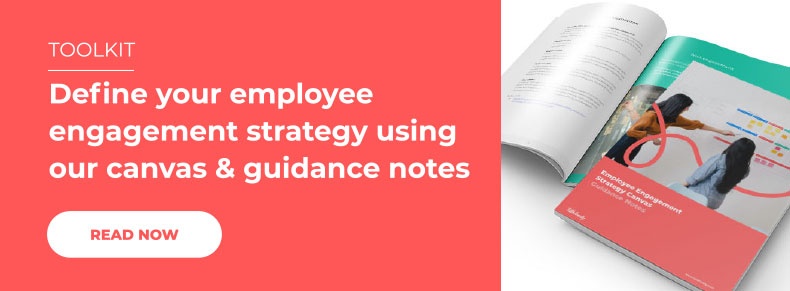Everyone wants an engaged workforce. It’s the blueprint for success. Especially in these uncertain times when it’s hard to predict which way the economy is heading. Just ensure your employees are fully motivated and engaged, and you can ride out any storm.
But, before you launch full-throttle into building your strategy, you need to distinguish between the different types of employee engagement within a workplace. After all, engagement is not a one-dimensional concept. Businesses need to differentiate between employees’ engagement with their job and their engagement with the organisation as a whole. After all, employees can be highly engaged with their jobs, but not feel connected to the overall organisation or vice versa.
When considering employee engagement, it’s worth making that all-important distinction between the two types; work engagement and organisational engagement. Only then can you put separate strategies in place to address the differing requirements. A multi-faceted employee engagement model is needed to fully address motivation and engagement in the workplace.
In this blog, we look at the critical differences between work engagement and organisational engagement and a real-life example of what happens when you get the balance wrong. We then explore employee engagement strategies needed to address these distinct forms of engagement. Only then will you have a comprehensive approach to employee engagement that covers all angles.
The two types of employee engagement
Before you can build and improve on levels of engagement at work, you must understand what these terms mean, and the different ways in which they can be used.
So, what is employee engagement? It can be split into two distinct elements:
- Work engagement
- Organisational engagement
In simple terms, the primary difference between these two ideas is the target of the motivation. A research paper from the Institute for Employment Studies highlights the need for a multi-faceted approach to engagement:
‘Employee engagement levels are consistently low despite the best efforts of many organisations. Viewing engagement as a single concept, rather than adopting a multi-faceted approach, may be contributing to this.
Organisations should draw a distinction between the different levels of engagement to facilitate targeted, evidence-based interventions which enable them to meet their desired business outcomes more effectively.’
Megan Edwards, IES
Dimensions of work engagement
Work engagement has been described as “the relationship of the employee with his or her work.” The main focus here is usually on the individual's role within the company; the part they play, and how motivated and committed they are to this role and its position within the business hierarchy. Personal role is a key dimension of work engagement.
A positive engagement at work includes perceiving a deeper meaning in work carried out, which extends beyond merely the next wage packet. The worker will assign value to their role, and this is likely to be tied to their self-perception. In short, their role is a part of who they are, as opposed to a separate, disparate entity.
How the individual feels about their job is crucial here; if they perceive it as valuable, important and making a real difference to the bigger picture, employee engagement is likely to be far higher. An engaged employee will care about the broader organisation, and work to progress the goals and targets of the whole.
Work engagement in a nutshell:
The definition of engagement at work focuses not only on the employee's role, but how they feel their role contributes to the company as a whole. Do they feel valued? Appreciated? Important? If so, you’ve achieved work engagement.
Dimensions of organisational engagement
Organisational engagement casts the net a little wider. Rather than focusing solely on the individual, it instead encompasses “the emotional commitment the employee has to the organisation and its goals.” Improving organisational engagement will have significant advantages for businesses; if everyone involved is equally committed to the common goal, productivity and motivation will increase.
Ensuring organisational engagement at every level is a real challenge for businesses. There is a risk that employees will see their roles as singular, rather than holistic; a job to be done, left and forgotten about outside the workplace. Successful organisational engagement requires commitment and dedication to the cause, and the chance to see the bigger picture. This multi-dimensional view is at the heart of employee engagement theory.
Overall, employee engagement requires both of these elements to thrive. Without strong work engagement, employees will fail to appreciate the value of their work on a wider scale, making successful employee engagement impossible.
Organisational engagement in a nutshell:
It’s all about the big picture. When employees understand what the company is trying to achieve, and care about the reason for reaching these goals, you’ll have a workforce that pulls together and works harder.
Getting it wrong: a painful example
If organisational engagement seems like a ‘nice to have’ rather than an essential, think again. Here’s a real-life employee engagement example of what happens when a company disregards the importance of organisational engagement and its impact on its profits.
- An engineer visits a home to fix a broadband issue. He is helpful, capable, and goes out of his way to do a great job. The homeowner is impressed by his service levels.
- The homeowner mentions that the broadband service is due for renewal soon. The engineer smiles and gives a wink. He then reveals three methods to get the best deal possible; all of which involve aspects of leaving the broadband provider.
- The homeowner follows this advice and secures a considerable discount on the broadband service.
So, what do we take away from this story? It’s certainly not unusual, and many of us will have experienced similar scenarios. This is where the dimensions of work engagement alone are not enough to produce a successful sales result.
Work engagement level:
Very High. The engineer prides himself on delivering an excellent service and leaving his customer happy.
Organisational engagement level:
Very Low. The engineer feels no commitment to the wider organisation and proceeds to undermine it to achieve customer satisfaction.
Result:
A happy customer, who is now generating less profits for the company. However, with organisational engagement in place, that customer would still be paying the rack rate and be just as happy with the service levels.
Work engagement strategies
As we have discussed, the secret to achieving overall employee engagement is the harmonisation of these two crucial elements. Initiatives to improve employee engagement are the first step in the road; in the first instance, workers need a strong work engagement. There are many steps companies can take to help implement this, and these include:
Work engagement step #1 - Allow flexibility
The importance of a strong work-life balance has been well-documented in recent research. Helping to facilitate this is a significant first step towards earning brownie points with your team and can result in increased motivation and productivity for their role.
When you’re looking at working life employee engagement and motivation, flexibility is a key element for success.
Contemplate allowing a little leeway regarding where and when work is completed. Perhaps consider offering the option of compressed hours, the chance to work from home even now remote working is no longer a necessity, or a more flexible schedule. People have become used to managing their own schedules and appreciate the freedom to continue. These employee engagement initiatives are a great way to build trust; perfect for generating workplace employee engagement.
Work engagement step #2 - Create a community
When considering methods for boosting workforce engagement, always look at how to create a sense of belonging in the workplace. If an individual feels they are a crucial member of a smaller team, chances are high that this attitude will transcend their immediate environment and permeate the wider organisation.
Make sure everyone has a chance to have their voice heard, that their ideas are actioned where possible, and that team spirit is promoted and maintained. An employee engagement app is a great way to launch this community concept. It will allow you to create social spaces for employees to meet, chat and share ideas and information, whether or not they are working from home or office-based.
Work engagement step #3 - Offer rewards
At heart, humans are fairly simple souls, and we all enjoy receiving recognition for the triumphs we have achieved. It’s one of the key drivers of employee engagement. It can be easy for feedback to fall into a largely critical variety, with plenty of goals and targets for success. These are crucial for allowing employees to progress and develop, but should be balanced with reward and recognition whenever possible.
An employee engagement platform will provide a quick route to implementing a reward and recognition programme. Built-in recognition modules allow employees to come together to celebrate success, understand company values and say thank you. Peer-to-peer recognition is as important as praise from the boss. It’s one of the main components of employee engagement and a simple but effective way to improve engagement at work.
Organisational engagement strategies
Good organisational engagement can come primarily from ensuring secure work engagement throughout the business. In addition, it is imperative that there is a clear chain of communication, an established hierarchy, and a real sense of seeing things get done.
Organisational engagement step #1 - Ensure clear communication
Whether via an employee engagement app or an internal communications system, it is crucial that staff know how they can have their voice heard. By setting out the channels of communication clearly from the start, employees will feel confident that there is a secure management system, and that their concerns and ideas will be taken seriously.
When looking at how to increase employee engagement in the workplace, it’s vital to ensure that everyone is receiving the same messages at the same time. It's essential to ensure that no one falls out of the loop. You need to make sure you’re reaching everyone; whether they’re at home, at the office or on the move. Only then do you know that the bigger picture is being received and understood.
Organisational engagement step #2 - Allow employees a voice
As you ascend the business hierarchy, it is easy for the voices of those further down to become muffled. This can result in frustration for workers; they may feel that their efforts will never be rewarded, no matter how hard they try. Investing in a quality employee engagement program is a great way to reach every member of every team, from top to bottom.
Feedback and pulse modules will help you keep a check on the health of the organisation and the mood of your employees. Collating feedback is one of the employee engagement best practices you should never ignore. Schedule a regular flow of feedback opportunities, asking about job roles, company policies and work conditions, to ensure you really know what’s going on at the coalface.
Organisational engagement step #3 - Ask for ideas
If you’re struggling to get your employees onside, ask them to contribute ideas and innovations of their own. The simple act of considering the broader aims of the company as they come up with suggestions will help them to understand the bigger picture. It gets them thinking on a scale beyond the limitations of their job role. If employees see one of their ideas implemented, the buy-in will be that much more effective. This should be one of your main employee engagement objectives.
What’s the best way to ask for ideas? The old concept of a suggestion box may have fallen by the wayside but innovation is still alive and well in the workplace. An employee engagement platform will make life easy for you, with in-built innovation modules to post challenges and capture ideas. It will also track your idea management workflow to ensure those excellent ideas are implemented.
Building engagement at work
In conclusion, it seems clear that employee engagement is a delicate balance of two aspects: work engagement, and organisational engagement. We have seen how these two concepts are required to work in unison to ensure success.
Now, more than ever, job security and a sense of belonging are crucial elements of any successful workplace. For individuals to perceive and envision themself as part of a greater whole - in this case, the wider organisation - employers must first ensure that there is security, motivation and satisfaction within their everyday work. This is at the heart of every successful employee engagement model.
With a few minor changes, managers and leaders have the opportunity to transform the ethos and mood of their entire business. Bring together the two core elements: work engagement and organisational engagement, and you’ll see positive change for all involved.








.jpg)
.jpg)